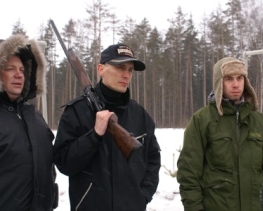Thieves by Law

The Russian Mafia is intensely fascinating. From their excellent (read: mental) taste in tattoo symbolism to their arcane codes and the way they infiltrated every facet of Russian life, there’s no part of them that doesn’t excite the imagination. And when you’re watching interviews with three of the big-time criminals (sorry, two criminals and one “legitimate businessman”), you know you’re in for a treat.
The film starts by giving us a brief history of the Ganavim Ba Hok (“Thieves by Law”): their origins among the criminals and political prisoners that were sent to Stalin’s gulags; the culture that they created among themselves; and the development of their codes, traditions and the tattoos that tell the story of their lives and their criminal careers. Moving on to Gorbachev and the opening up of the free market, we’re told how the Thieves by Law really came into their own by alternately extorting/protecting the new businessmen, until they almost formed their own para-state.
The personalities of the three gangsters, who are rendered in almost cartoonish detail, loom large over this documentary. There’s Leonid, a mafioso of the old school obsessed with honour and tradition, with a soft spot for fine art and the church. There’s Alimzhan, a “businessman” who simply can’t understand why all these other countries are persecuting him when all he wants to do is sail his legitimately acquired yacht legitimately around. And finally there’s Vitaly, winner of the “Cliched Russian Baddie Face” award 1995-Present, who’s an (ex-?)brutal thug turned amateur filmmaker, who wants to direct movies about the golden-era of the Russian mob.

As they tell their stories, it’s hard to separate fact from fiction, and indeed no attempt is made to do so. This is the testimony of these men, and in many ways what they talk about and how they do so is far more important than whether or not it’s true. Has Leonid really only ever cried once, when he was unable to kill a man who had made an attempt on his family because the police caught him first? Maybe, maybe not. What’s really important is why he chooses to share that story. And there’s a real charm to them: when Vitaly is hanging around with his big bearded enforcer, reminiscing about the horrible violence they used to inflict on people, it’s hard not to laugh along with them.
But more than anything, there’s the sense of a completely alien culture. Russia seems, on the surface, to be part of Europe, but underneath everything is different on a very basic, social level. The concept of a “Krisha” is especially noteworthy, as they each explain in their own ways how the Russian Mafia worked. The Krisha (or “roof”) was a businessman’s own personal gangster, who extorted money from them in exchange for protecting them from extortion or violence from others. Regardless of the industry (cars, drugs, restaurants, prostitution, whatever), the Mafia were protectors and robbers, rather than providers. At one point Leonid says “Some people were protected by the police, so we couldn’t touch them”. In the Russia of the 80s and 90s, the police were just another gang providing a Krisha.

There’s more, of course, the gang violence and deaths, the relationship between the State and the mob (the prison system especially), but if you have even the vaguest interest in criminality or organised crime, you’re already on your way to see this film. At the end, each of the interviewees is asked why they agreed to be interviewed. Leonid’s answer is the best: “Because all these people are dead, and if I didn’t, a layer of the story would have been lost”. And this is where Thieves by Law excels, as a layer to the story. A snapshot of a Russia which has gone, but not very far.






Recent Comments